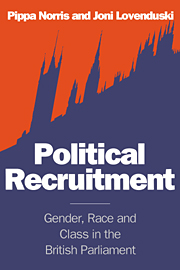Book contents
- Frontmatter
- Contents
- List of figures
- List of tables
- Preface
- 1 Puzzles in political recruitment
- Who selects and how?
- 2 The structure of political recruitment
- 3 Conservative recruitment
- 4 Labour recruitment
- 5 Minor party recruitment
- Who gets selected, and why?
- Does the social bias matter?
- Appendix A Details of the survey design and sample
- Appendix B Questionnaires
- Notes
- Bibliography
- Index
3 - Conservative recruitment
Published online by Cambridge University Press: 07 December 2009
- Frontmatter
- Contents
- List of figures
- List of tables
- Preface
- 1 Puzzles in political recruitment
- Who selects and how?
- 2 The structure of political recruitment
- 3 Conservative recruitment
- 4 Labour recruitment
- 5 Minor party recruitment
- Who gets selected, and why?
- Does the social bias matter?
- Appendix A Details of the survey design and sample
- Appendix B Questionnaires
- Notes
- Bibliography
- Index
Summary
One of the most remarkable features of the Conservative party is the way it has usually managed to maintain unity, with little public discord between the leadership and local associations. This is particularly evident in the Conservative selection process where disagreements have usually been resolved discreetly behind closed doors, by a process of informal discussions between leaders, MPs and local associations. This is in marked contrast to Labour, where factional disputes over the adoption of candidates have been far more common, and there have been heated conference battles over the selection rules.
The aims of this chapter are threefold. The first is to describe the main steps in the Conservative selection process as it operated during the 1987–92 parliament, to understand how it works from the perspective of participants. The second is to summarise how the process has gradually evolved over time from a ‘patronage’ towards a more ‘meritocratic’ process today. Lastly, the chapter concludes by analysing how the Conservative process has functioned effectively to maintain party unity. Broader issues, including explanations of the outcome of the selection process, will be left until they can be explored in depth in later chapters.
The main steps in Conservative selection
The role of Central Office
The Conservative party has three components: the parliamentary party consisting of the party leader, MPs and Conservative peers; the National Union of Conservative Associations which links constituency parties in England and Wales, and is primarily responsible for organising the annual conference; and Central Office.
- Type
- Chapter
- Information
- Political RecruitmentGender, Race and Class in the British Parliament, pp. 34 - 52Publisher: Cambridge University PressPrint publication year: 1994



